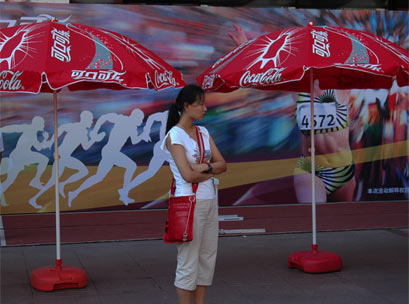Meet Meimei and her cousin Mei Lyn: they represent a sophisticated new Chinese retail consumer…
Meimei is a typical late 20-something Shanghai woman. She’s one of the new generation of consumers growing at an unprecedented pace in a nation with a 30 year average annual economic growth rate nudging 10 per cent.
Meimei is, for the purposes of this article, a composite of consumer profiles described by no less than five presenters on the Westfield Asian Express Retail Study Tour – presenters experienced in market conditions throughout the Asian continent, presenters based in Shanghai, Singapore, Kuala Lumpur and Hong Kong.
Meimei and her friends are getting richer faster than consumers in any other part of the world – and certainly faster than her parents, and their parents, who can now but marvel at the freedom and choice Meimei’s generation has in 2010.
Chinese households with more than A$12,000 annual income now account for 200 million consumers in mainland China, according to Chris Jackson, assistant executive director Hong Kong Trade Development Council.
“That’s a lot of disposable income there – and it’s growing fast.”
One of those 200 million, Meimei has an Apple iPhone – and her friends also have internet-enabled phones with which they can connect to Renren – China’s home-grown alternative to Facebook (which is blocked by China’s government). Her friends helped Lenovo sell one million smart phones in China in 2010.
Meimei is a sophistcated shopper and brand savvy, thanks to the internet. She can rattle off the names of 72 brands with little effort. And she’ll happily splash out on any new product that sets her apart from the crowd. She reads blogs, is aware of the social credibility of brands and cares about sustainability – you won’t be able to pull the wool over her eyes on either.
If she’s bought your retail brand once she’ll buy it again – but only provided you maintain consistent quality, service and style.
Meimei’s looking forward to her first overseas trip, waiting for her friends to decide if it will be a shopping excursion to Hong Kong or a week’s sightseeing further abroad. Whichever destination, she’s saved enough for shopping. She even has a credit card.
Meimei is the atypical young Chinese consumer Anson Bailey, principal, business development, with KPMG’s China consumer division, describes when he says the top two reasons Chinese consumers splurge in shops are to reward themselves, and pamper themselves.
“We see the rise of a sophisticated Chinese consumer. I see that every day of the week I am travelling across the cities of China, not just in Shanghai and Beijing, but other cities like Nanjing and Chendhu.”
The average wealth in China has grown by 64 per cent in the last two years, says Bailey, with property one of the biggest drivers. Meimei is likely to work in healthcare, IT, or retailing, amongst the fastest growing areas of the economy.
Meimei is nowhere near being a billionaire. She’s decidedly ‘middle class’ with an income a fraction that of a 25 year old Sydney graduate. But there are an estimated 1363 Chinese with a billion Chinese Yuan of assets – 36 per cent more than there were in 2009 and 1339 more than a decade ago. (1 billion Yuan = A$152.4 million).
But Meimei has a successful uncle who occasionally gives her a lift to the new IFC Mall in Shanghai’s Pudong business hub, judged Asia’s best mall by the ICSC in November. He gives her a lift in his new Porsche, one of 3500 of the sports car marque sold new in China in 2009. In 2001, Porsche sold just 40.
A six hour flight away, Meimei’s theoretical cousin in the Malaysian capital of Kuala Lumpur, Mei Lyn, has similar aspirations. Like Meimei, she has a degree (six million Chinese graduated from university in 2010). She’s used to brands, used to those modern, shiny temples of retailing we call malls. Mei Lyn works in an office where, again, she won’t earn as much as her ilk in Sydney. But it wouldn’t be uncharacteristic for her to blow 80 per cent of her monthly salary on a watch or a brand name handbag.
“People in Asia want to be seen to be wealthy and successful,” explains Australian Andrew Brien, CEO of Suria KLCC, in downtown Kuala Lumpur. That’s why it is not unusual to see someone with a $200,000 home and $400,000 worth of motor vehicles parked outside, he says.
For people like Mei Lyn, and her parents’ generation, too, shopping is a sport.
“We put 42 million people a year through KLCC,” explains Brien. That’s more than 100,000 people a day, the equivalent of a full house at ANZ Stadium.
“The mall in Asia is an extension of the shopper’s home.”
Mei Lyn will spend a disproportionate amount of her time in shopping malls, either with family or with friends. It helps she can shop as late as 10pm any night of the week.
And she’ll dine there, too.
“People don’t eat at home. Our foodcourt seats 1150 people and does 10,000 transactions a day. It’s a reason for going out.”
To put those figures in perspective, Brien compares Suria KLCC with Westfield’s Bondi Junction – centres of similar floor size. Where Bondi Junction hosts between 30 and 35 dining outlets, Suria KLCC boasts 80.
“If you’re a fashion retailer and you can link into food it’s not a bad thing.”
Meimei and Mei Lyn share one thing in common with their middle class Asian ilk throughout the region: they’re obsessed with beauty. Whether it be Singapore, Kulala Lumpur, Shanghai, Bangkok or Hong Kong, women crowd department store cosmetic halls, beauty shops and pop-up make up studios.
The diversification and specialisation of the beauty industry in Asian retailing is one of the most obvious retail trends in Asia as the spending power of young and middle aged consumers grows strongly and consistently.
Where visitors used to see single destination spas in shopping centres, now you’ll see whole precincts with an array of beauty processes and products aggregated much like an upmarket food court. Traditional nail salons have been augmented by eyebrow treatments, waxing clinics, skin treatments using mud from the Dead Sea – and stores offering health products combining traditional Chinese solutions with western style. In Singapore, there is even a clinic which specialises in selling dietary supplements tailored to suit the customer’s blood type!
Across Asia, explains Bailey, health means wealth.
Especially in Singapore, home to one of Asia’s most affluent communities. While brands have really only infiltrated China in the last decade, in Singapore they’ve been established for more than 40 years.
In the 1970s, explains Douglas Benjamin of retail conglomerate and brand licensee FJ Benjamin, ‘country of origin’ was a status symbol. In the ‘80s, labels became more important. “It didn’t matter where they came from as long as they were labels.”
Then came the ‘90s with luxury brand names elevating one’s status – and the rise of the lifestyle brands.
“Twenty years ago we had nothing like Guess or Zara or middle brands,” recalls Benjamin. “We only had very high end designer labels or very low end local labels. When we brought Guess? in (to Singapore), it turned retail on its head.”
Now, Meimei, Mei Lyn and their contemporary in Singapore are more than likely embracing the new ‘masstige’ trend, which has migrated from the North American and European markets – luxury branding at a mid-mass price point. And she’ll mix an expensive designer brand top with jeans from Japan’s Uniqlo or Spain’s Zara.
Modern Asian consumers, says Benjamin, are embracing clothes designed by high end labels for high street shoppers.
“A/X, Raoul, Bebe, Banana Republic, Ted Baker, Ben Sherman, Massimo Dutti: People can trade up or trade down. It’s very different to the way people were shopping in the ‘70s and ‘80s – then they chose one brand and one look.
“Then Sharon Stone wore a Gap t-shirt and an Armani skirt to the Oscars – that told people you can mix and match.”
Meimei and Mei Lyn’s boyfriends are not missing out on the revolution either. Asia’s male consumers are increasingly educated, brand savvy and well-travelled.
Benjamin identifies menswear as “probably the fastest growing section of the Asian retail market today”. He refers to “the emergence of the male consumer” which is evident in many retail categories, not just apparel – technology, gadgetry, accessories, eyewear, motor vehicles…
And the men’s businesswear category is “by far the fastest growing and most profitable business” for FJ Benjamin, “because men have embraced the whole looking after themselves concept”.
Indeed, many participants in the Asia Express tour noticed a considerably broader range of menswear stores and brands and a vastly greater selection of men’s clothing – from casual to formal – than can be found in Australia. And at often significantly lower price points.
There are more menswear brands in China and southeast Asia and a far broader choice.
This feature first appeared in Inside Retailing Magazine. Click here to subscribe.






